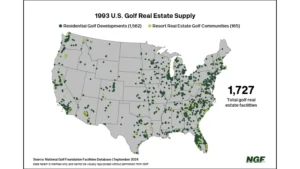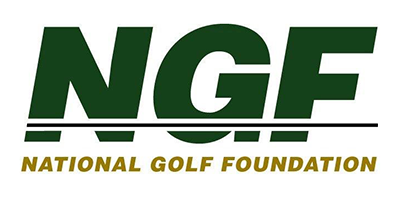But many golfers share the dream of owning a house with a fairway view from the other side of the out-of-bounds stakes.
There are approximately 3,200 golf facilities in the U.S. with a real estate component, whether as part of a residential community or a resort real estate complex. That represents nearly 23% of overall U.S. golf supply.
Through NGF’s economic impact research at the state and national levels, we’ve found homes on golf courses have experienced a 15% bump in property value, on average. Obviously, this can vary depending on geography and the type of home and golf facility, not to mention location on the course itself. But golf course living, in general, is enjoying a rebound like the game itself in the post-pandemic era.
Golf-related real estate is a topic we’re asked about frequently and a subject our consulting team addresses regularly with developers and municipal planning boards or other authorities.
 Historically speaking, real estate was a major component – a driver, even — of the broader golf course building boom in the U.S. from 1986 to 2005. Almost 4,000 new facilities opened during this 20-year period and about half of those involved real estate. It was an unprecedented period of entrepreneur-driven development, and unfortunately, the golf “product” created was homogenous… “championship” style courses that were expensive to build, maintain and play.
Historically speaking, real estate was a major component – a driver, even — of the broader golf course building boom in the U.S. from 1986 to 2005. Almost 4,000 new facilities opened during this 20-year period and about half of those involved real estate. It was an unprecedented period of entrepreneur-driven development, and unfortunately, the golf “product” created was homogenous… “championship” style courses that were expensive to build, maintain and play.
When the real estate bubble burst, precipitating the Great Recession, golf felt the brunt.
Since 2010, the national number of real estate-related golf facilities is down 4%.
The past few years have seen a slight uptick in supply, as a healthier supply/demand balance across the industry has led to a new era in residential golf development. While we’re not seeing anything like the golf real estate development in the “boom” years, 42% of current projects in-planning or under construction have a housing component – compared to just under one-quarter of existing national golf supply overall being associated with real estate.
Florida is far and away the leader when it comes to golf communities, with twice as many as the next closest state (California). The Sunshine State has more than 500 residential golf developments alone, more than half of which are private, and at least a dozen more are in the pipeline. California, Texas, Arizona, North Carolina, and South Carolina are the only other states with at least 100 residential golf developments.
Members can license NGF’s definitive database of real estate facilities and find additional details on the top golf real estate markets in this sidebar Full Shots story, from historical trends and economic impact to the U.S. counties and cities with the most residential golf communities.


